In part 1 of this article we visited the Entrance Plaza, the Arid House and the Southern Africa section. In part 2 we will check out the New World Desert, the Tropical House and the Australasia section.
 |
| Tour Deck overlooking the New World Desert |
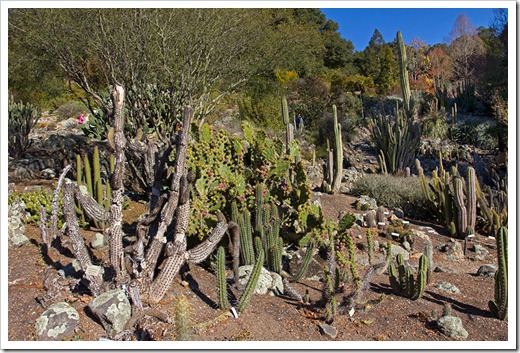 |
| New World desert |
 |
| New World desert |
The New World Desert is located right across from the Southern Africa section—very fitting considering that plants from both parts of the world have similar growing requirements. While not very large, the New World Desert still contains a wide range of cacti and succulents, including many rarely seen in cultivation. There are very large clumps of agave and towering columnar cacti, but they were impossible to photograph because of the noon sun that created harsh shadows. Instead, I’m going to show you smaller plants that I found particularly interesting.
The first is a tree sedum (Sedum torulosum) from Mexico. “Tree” may be a bit of an exaggeration, but apparently it can grow to 3 ft. What makes this species different is the thickness of the stems in proportion to the leaf size. It certainly is a rather strange looking plant.
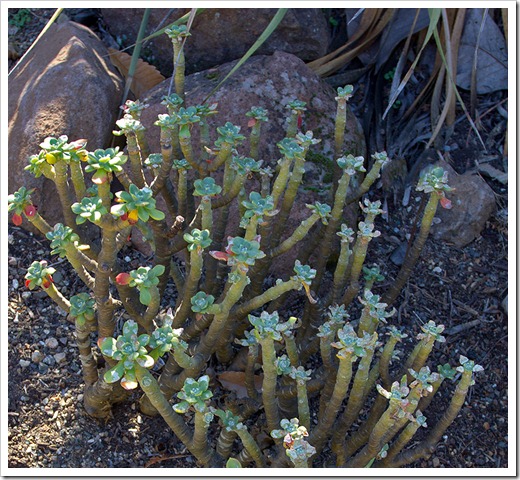 |
| Tree sedum (Sedum torulosum) |
This Agave guadalajarana is tucked away near the restrooms. If you don’t have to use the facilities, you will miss it. That would be a shame because it’s a very striking agave and seeing a large specimen is a treat. (Juvenile plants offered for sale do not do it justice.) Unfortunately, Agave guadalajarana is one of the least cold-hardy agaves, which is why I don’t have one in my collection.
 |
| Agave guadalajarana |
I must be particularly attracted to the color blue at the moment, judging from the photos I’ve picked for this post. You saw quite a few blue plants in part 1 and here is another one, a blue barrel cactus from eastern central Mexico. These three specimens of Ferocactus glaucescens had the typical grayish blue coloration that contrasts so nicely with the yellow spines. Ferocactus glaucescens is at the very top of my cactus wish list for 2012. Unfortunately, it’s not very hardy, so I’d keep mine in a container that can easily be covered on a cold winter night.
 |
| Ferocactus glaucescens |
 |
| Ferocactus glaucescens |
While Ferocactus glaucescens is solitary or has a small number of offsets, the Mammillaria compressa in the next photo forms huge clumps up to 3 ft. wide resembling mounds with spines. Apparently it is sometimes called “Mother of Hundreds” and looking at the clump in the next photo, you can definitely see why.
 |
| Mammillaria compressa |
The next plant is taking the meaning of “clump” to a whole new level. Deuterocohnia brevifolia is a terrestrial bromeliad (in other words, a pineapple relative) from Argentina and Bolivia that is able to completely cover rocks, as you can see in the next two photos. A mat actually consists of thousands of 1 to 2 inch rosettes clustered together seamlessly.
 |
| Deuterocohnia brevifolia |
 |
| Deuterocohnia brevifolia |
As beautiful as round cacti are, there’s something even more special about columnar cacti. I’m particularly fond of the hairy species native to high-altitude regions of the Andes. The hair is often so dense that it completely covers the green epidermis, providing protection against the strong UV radiation found at extreme elevations.
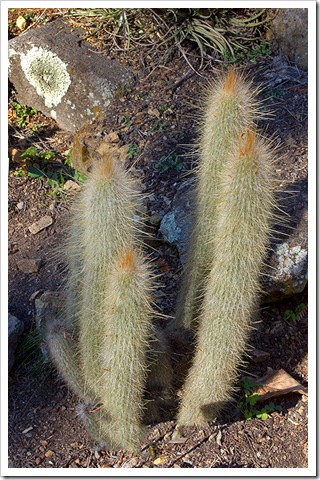 |
| Cleistocactus hyalacanthus |
While the Cleistocactus hyalacanthus above are only 1-2 ft. tall, the colony below is about 6 ft. I have several Cleistocactus straussii in containers, and they have proven to be very fast growers—extra water and fertilizer in the summer have certainly helped. As nice as they look in a pot, nothing can beat the results you get when planting them in the ground.
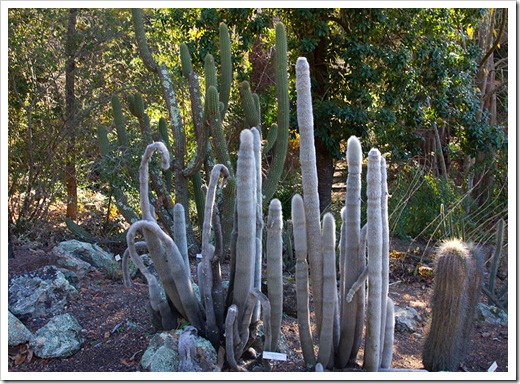 |
| Cleistocactus straussii var. fricii |
I don’t know why the stem in the next photo (on the left) was cut off but the cactus responded by growing a new arm. These plants are tough and will do anything they can to survive. And even after they die (photo on the right), they still look interesting.
 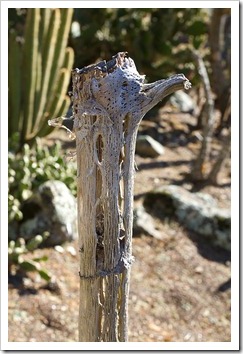 |
| Echinopsis peruviana |
The genus Opuntia includes not only the prickly pears of the Southwest, but also many South American species (although some of them have been split into different genera by some taxonomists). The following is Opuntia kuehnrichiana from Peru. I must admit that I had never heard of it before, but I think it’s a very attractive cactus.
 |
| Opuntia kuehnrichiana |
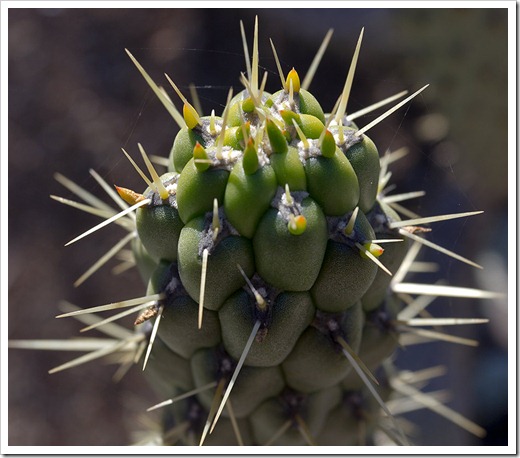 |
| Opuntia kuehnrichiana |
Shown in the next two photos, Agave shawii is found along the Pacific coast of Baja California. It’s a relatively small agave; each rosette is no larger than 3 x 3 ft. It offsets freely and can form large colonies. What’s remarkable about this species is that it forms a more or less horizontal stem that creeps across the ground. In this specimen, small plants seem to be growing directly from the stem. I’ve never seen this type of growth in any other agave.
 |
| Agave shawii |
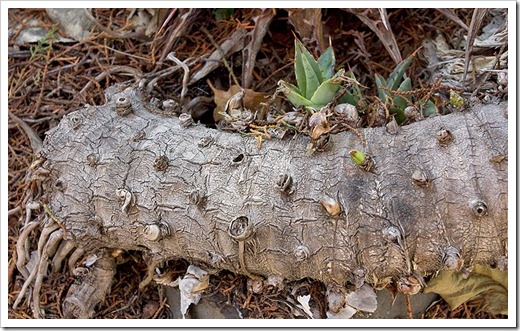 |
| Agave shawii stem |
The next agave, Agave parryi ‘Truncata’, is anything but rare. In fact, it’s one of the most common found in gardens. But since it forms such perfectly symmetrical rosettes of a striking gray color, I simply had to include it in this post. Easy to find, very hardy (zone 6b), and a beauty—everybody should have one!
 |
| Agave parryi ‘Truncata’ |
The New World Desert is bordered to the south by a thicket of terrestrial bromeliads that seem to shimmer in the sun. I wasn’t able to find an ID tag, but to me they look like puyas. They might be Puya coerulea var. violacea, but they’re noticeably more silver than my own Puya coerulea var. violacea. I’m still trying to obtain a positive ID. In any case, they form a unique backdrop for this bench. I did sit there for a minute, but I was very aware of the spiky expanse all around me. Awe-inspiring, otherworldly, and dangerous.
 |
| Bench surrounded by terrestrial bromeliads, probably puyas |
Leaving the New World Desert behind, we headed into the adjacent Asia section. Unfortunately, the light was too mottled to take good photos inside the stands of trees and of the lovely Japanese Pool (complete with two large granite lanterns).
Right on the edge of the garden boundary is a small bamboo grove, and there I found not only a well maintained grove of Phyllostachys vivax, but also the most twisted and gnarled California buckeye (Aesculus californica) I have ever seen. While it’s native to California (not Asia), it fits right in. Who knows, this tree might have been there when the garden was built, and they decided to simply leave it. It’s living sculpture at its most impressive.
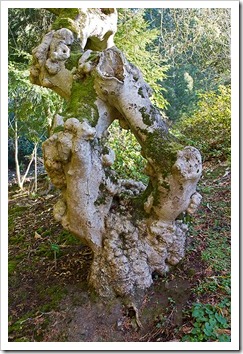  |
| California buckeye (Aesculus californica), the largest and most twisted specimen I’ve ever seen. In Davis, they’re typically large shrubs, not 20 ft. trees. |
 |
| Phyllostachys vivax, neatly thinned so the individual culms can be admired. The overall effect is light and airy. |
In the Asia section, I saw quite a few blooming azaleas. That surprised me because I thought they don’t flower until later in the spring. Here is one juxtaposed with a large Japanese forest grass (Hakonechloa macra), dormant for the winter.
 |
| Blooming azalea and Japanese forest grass |
Entering the Australasia section, I was excited to find a number of Tasmanian tree ferns (Dicksonia antarctica). Many were tall enough to stand under. For a moment, I felt transported back to Tasmania where I saw specimens 12 ft. tall. We have two tree ferns in our backyard—a Dicksonia antarctica in a pot and a Cyathea cooperi in the ground—but to say they are glacially slow-growing would be an understatement. Maybe in a cooler, more humid environment they grow faster. In our bone-dry Mediterranean climate with 100°F summers, they barely hang on.
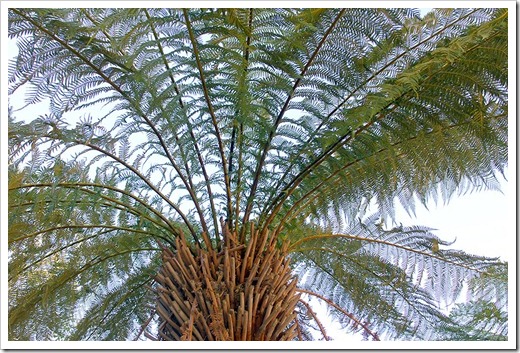 |
| Dicksonia antartica |
 |
| The Dicksonia antartica on the right overhangs the path, giving the illusion that you’re bushwhacking through the jungle |
 |
| These three Dicksonia antartica are right outside the conference center. They’re neatly trimmed so as not to encroach on the path. |
Our final destination, the Tropical House, is surrounded by the Cycad & Palm Garden. Some of the cycads shown in part 1 were photographed here. The next time I visit, I want to spend a lot more time in this section, exploring the many palms. Here are just a couple I found particularly beautiful, not just because of their fronds but also because of their trunks.
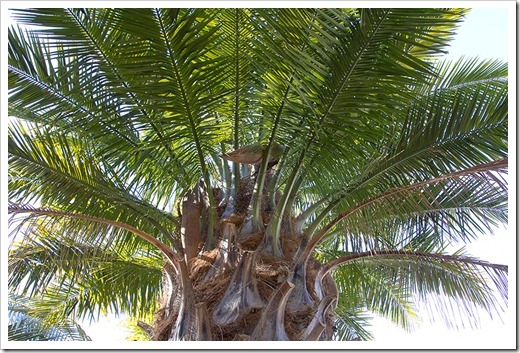 |
| Chilean wine palm (Jubaea chilensis). This massive tree can grow to 80 ft. It’s still very rare in Northern California although it’s reputed to grow well here (albeit slowly). Here is an impassioned write-up about Jubaea chilensis by Gary Gragg, owner of Golden Gate Palms & Exotics in nearby Richmond. Gary also had great landscaping show called Superscapes on Home & Garden TV. Unfortunately, it isn’t on anymore, but there are occasional reruns. |
  |
LEFT: Chilean wine palm (Jubaea chilensis)
RIGHT: Palmetto (Sabal sp.) |
The Tropical House is small but it contains quite a few interesting plants nonetheless. Every few years the Tropical House gets media attention when one of their corpse flowers (Amorphophallus titanum) starts to bloom. I was fortunate enough to see a specimen at UC Davis in bloom this past summer, and it really is an unforgettable sight (and smell).
Even when not in bloom, Amorphophallus titanum is a extraordinary plant. When actively growing, it produces a mottled green “trunk” up to 20 ft. tall with a canopy of green leaves. At least that’s what it looks like (check out the potted plant on the left in the photo below). In reality, the entire structure—trunk and leaf canopy—is one giant leaf. Yes, just one leaf. The leaf produces energy that goes right into the underground corm. Each leaf lives for 1-2 years, then dies. After a period of dormancy (which can be up to 3 years), another leaf is produced. When the corm is large enough (at least 60 pounds), Amorphophallus titanum blooms. Over its 40-year lifespan, each corpse flower blooms only 2 or 3 times. Truly a strange and magnificent plant!
 |
View of Tropical House
The potted tree in the middle is a cocoa tree (Theobroma cacao) |
For me, the biggest surprise of the Tropical House was to see a cocoa tree (Theobroma cacao) with ripe and unripe fruit. We eat cocoa products almost every day, and yet who of us knows where cocoa really comes from? Check this Wikipedia article if you want to know more.
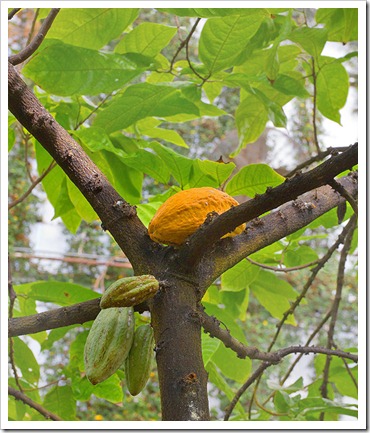 |
| Ripe (orange) and unripe cocoa fruit |
Just a few steps from the cocoa tree I encountered a coffee tree. I’ve seen them for sale at UC Davis Arboretum plant sales (strictly a house plant in our climate), but this specimen was much larger. What a treat to see the source of two of my favorite things in life (chocolate and coffee) in one spot! Even though they come from different parts of the world (Theobroma cacao from the New World, Coffea arabica from the Old World), they appear to share similar growing requirements.
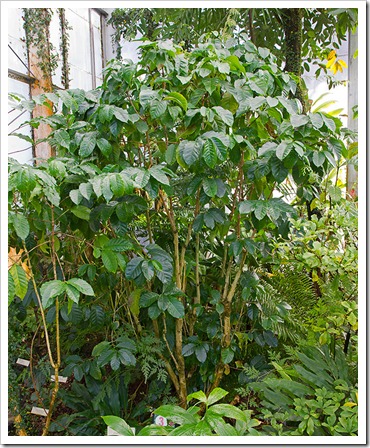 |
| Coffee tree (Coffea arabica) |
The final plant I’m going to highlight was also one of my personal favorites of this visit: Equisetum myriochaetum. Known as the Mexican giant horsetail, it looks like the common horsetail (Equisetum hyemale) on steroids. San Marcos Growers says that it can grow to 15 ft. and in spite of its tropical origins is hardy to 15-20°F. Like all its relatives, it requires constantly moist soils and has an invasive rhizome systems, but kept in check in a large pot, this could be a striking focal point in a garden. I’ll put it on my plant wish list for 2012!
  |
| Mexican giant horsetail (Equisetum myriochaetum) |
Speaking of plant purchases, several of UCBG’s nurseries offer plants for sale. The California Native, Asian Trees & Shrubs, and Large Cacti & Succulents nurseries are open to the public every Thursday from 10:30 am to 1:00 pm. Click here for more information and links to each nursery’s availability list. I’ve bought many plants from the Large Cacti & Succulents nursery over the years, and I’ve been impressed both with the size of the plants and the reasonable prices.




































A thoroughly enjoyable second instalment :)
ReplyDeleteAs for the Agave guadalajarana, I'm struggling to keep it alive even kept indoors. It seems to like lots of light and heat.
Thanks so much for the tour, what excellent in depth experience. For the garden deprived people of the north, it's a real treat to get a personalize visit. Canada lacks any serious tropical botanical garden, I've been itching to get in the car and drive south to see more. A friend of mine goes to Berkeley, I never knew how amazing their horticulture department was.
ReplyDeleteGreat Part II! You've inspired me to go back and look at my posts again. I was so overwhelmed (in a good way) when there.
ReplyDeleteI love the bench surrounded my dangerous spikes, oh how I would love to replicate that scene in my garden! And I remember how amazing those Equisetum myriochaetum were. If you end up buying it and have a mail order source I'd love to know it. Thank you for the tip about when to visit, next time a Thursday for sure!
Fantastic tour--thanks! Have you been to Lotus Land in Santa Barbara? They have (I think) some of the largest Chilean Wine Palms in the US--breathtaking.
ReplyDeleteMark, some plants are just too temperamental for me. I'm realizing that I don't have to have every single plant that strikes my fancy.
ReplyDeleteNate, let me know if and when you make it down our way. Would love to meet you in person. In addition to UC Botanical Garden, there's San Francisco Botanical Garden, another world-class institution.
Loree, I'll look up your posts about UCBG. No luck so far finding a source for Equisetum myriochaetum. Will keep you posted if I strike gold.
Hoover Boo, I've never been to Lotusland but we're planning a trip to Santa Barbara this coming summer. It looks like nirvana to me: succulents, cycads, Australian plants and bamboo all in one place.
What a wonderful place. I will have to go there some weekend. I looked at there web site and wow what a big place. thanks for the great photos!
ReplyDelete